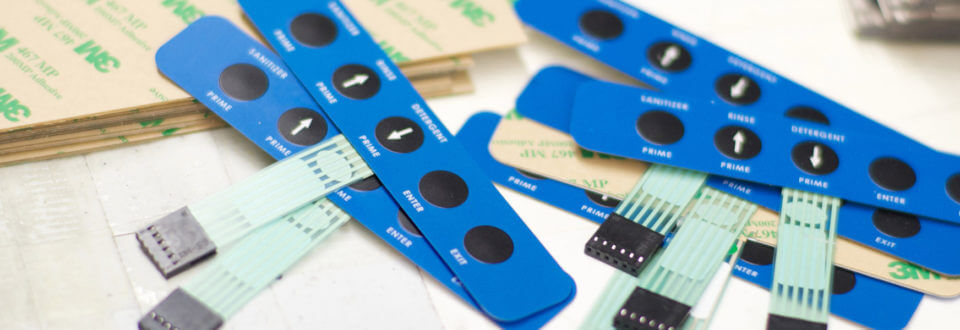The Impact of Membrane Switches on User Interface and Device Functionality
The Impact of Membrane Switches on User Interface and Device Functionality
Blog Article
Recognizing Membrane Layer Switches: The Trick to Trusted and sturdy Controls
Membrane layer changes stand for a crucial aspect of modern interface layout, blending capability with strength in various applications. These versatile components not just facilitate individual interaction yet are also engineered to endure the roughness of demanding environments, from clinical gadgets to commercial machinery. Recognizing their construction, operation, and the myriad benefits they use is important for developers and designers alike. As we discover the ins and outs of membrane layer switches, it ends up being clear that their role in improving control systems is both complex and profound, questioning about exactly how best to take advantage of their capacities in future advancements.
What Are Membrane Layer Switches?
Membrane layer buttons are an innovative remedy in the world of interface technology, incorporating performance and design seamlessly. These devices function as an interface in between customers and electronic systems, integrating several components right into a compact style. Normally created from flexible, slim layers of materials, membrane layer switches are made to reply to touch, allowing customers to interact with equipment and electronic gadgets effectively.
The primary elements of a membrane button consist of a printed circuit layer, graphic overlay, and a spacer layer that prevents unplanned activation. The visuals overlay can be tailored to mirror brand name identity or individual choices, enhancing looks while making sure functionality. Membrane layer buttons are generally utilized in numerous applications, including medical gadgets, consumer electronic devices, and industrial equipment, owing to their sturdiness and resistance to environmental aspects such as moisture and dust.
Among the key benefits of membrane buttons is their capability to hold up against wear and tear, making them perfect for high-traffic environments. Furthermore, they are lightweight and need minimal space, enabling for cutting-edge layouts in product advancement. Generally, membrane layer switches represent a effective and sensible choice for modern digital user interfaces, weding innovation with user-centric layout principles.

Exactly How Membrane Switches Work
The operation of membrane changes hinges on a simple yet reliable device that converts individual input right into digital signals. When an individual presses the switch, the leading layer warps, permitting a conductive element in the circuit layer to make call with a corresponding conductive pad on the bottom of the visuals overlay.
The design of membrane layer switches can differ, however they often include domes or tactile aspects to provide comments to the individual, improving the overall experience. The products utilized in membrane switches, such as polyester or polycarbonate, add to their toughness and resistance to ecological variables, including moisture and dirt. Moreover, the printed circuits are normally enveloped, which safeguards them from wear and tear in time.

Advantages of Membrane Buttons
Among the key benefits of membrane layer buttons is their convenience in style, permitting them to be customized to satisfy certain individual demands and aesthetic demands. This adaptability reaches different markets, where different shapes, dimensions, and colors can be utilized to boost individual communication and aesthetic appeal.
In addition, membrane switches are known for their resilience. Built from durable materials, they are resistant to dirt, wetness, and physical wear, which significantly extends their life expectancy compared to traditional mechanical buttons. This sturdiness makes them particularly suitable for high-traffic settings and applications calling for longevity.

In addition, membrane buttons offer a streamlined profile, bring about a thinner style that can be incorporated into various devices without adding bulk. This attribute not just enhances the aesthetic allure however also adds to a more ergonomic product design.

Applications of Membrane Switches
Easy to use and functional, membrane buttons discover applications across a variety of sectors, consisting of clinical devices, customer electronic devices, and industrial equipment. In the medical field, these switches are essential to tools such as diagnostic devices, patient tracking systems, and infusion pumps, where reliability and ease of cleaning are essential. Their ability to preserve and endure severe settings capability makes them ideal for such applications.
In consumer electronic devices, membrane see this here layer switches are used in items like microwaves, washing devices, and push-button controls - membrane switch. Their sleek design allows for user-friendly customer interfaces, boosting the total user experience while providing toughness and resistance to wear and tear
Industrial equipment also benefits from membrane buttons, especially in control panels for machinery and automation systems. These buttons use defense against dust and dampness, making certain constant efficiency in tough environments. Their customizable features allow makers to tailor them to details functional requirements, enhancing efficiency and functionality.
Choosing the Right Membrane Layer Change
When selecting a membrane layer switch, it is necessary to take into consideration different variables that affect performance and suitability for specific applications. The main dig this considerations consist of ecological problems, responsive responses, toughness, and style specs.
First, examine the operating environment; switches exposed to dampness, chemicals, or severe temperatures call for particular materials to make sure long life and functionality. Next, review the need for tactile feedback. Depending upon customer communication, some applications may take advantage of a tactile feedback to confirm activation, while others might prefer a non-tactile design for visual reasons.
Toughness is another essential element; membrane buttons must be designed to withstand constant use, effects, and abrasion. Guarantee the selected button can sustain the anticipated lifecycle, specifically in high-usage situations.
Verdict
In final thought, membrane layer switches over offer as important parts in the design of reliable and long lasting control systems across various industries. The adaptability of membrane switches enables for customized services that meet details operational needs, strengthening their Read More Here relevance in contemporary innovation.
Membrane layer switches over represent a critical element of modern-day user interface style, blending performance with strength in various applications.Membrane switches are an innovative solution in the realm of individual interface modern technology, integrating performance and style seamlessly. Normally built from adaptable, thin layers of materials, membrane layer buttons are made to respond to touch, enabling individuals to engage with machinery and electronic gadgets effectively.
The design of membrane buttons can differ, however they frequently integrate domes or responsive components to provide feedback to the customer, improving the overall experience.In verdict, membrane layer changes serve as necessary components in the design of trusted and long lasting control systems throughout numerous markets.
Report this page